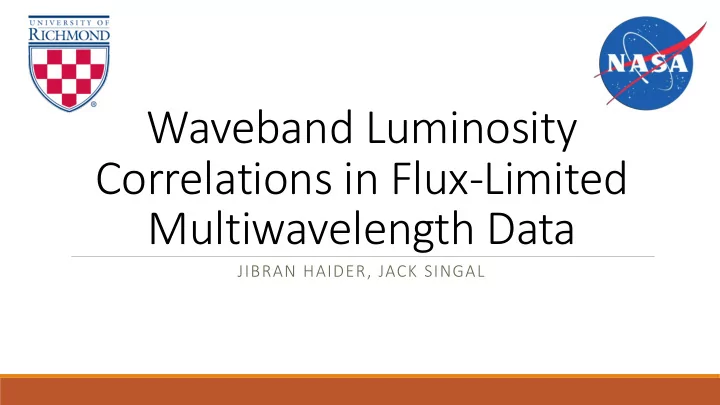

Waveband Luminosity Correlations in Flux-Limited Multiwavelength Data JIBRAN HAIDER, JACK SINGAL
Introduction • Knowing the intrinsic correlations between different waveband emissions is important in many astronomical questions e.g. • Radio-far IR correlation • Accretion disk vs. jet vs. torus emission in AGN • Let’s focus on quasars as an example…
Real optical-mid-infrared (SDSS x WISE) Real optical-radio (SDSS x FIRST) Do you see any correlation? Simulated optical-radio No intrinsic correlation!
How Did That Observed Correlation Get Induced? (SDSS x WISE Dataset) Infrared Optical Missing data!
Correlational Techniques in Bins • We use the Pearson correlation coefficient (PCC) as a measure of the linear luminosity-luminosity and luminosity-redshift correlations: 𝑦𝑧 = σ 𝑗 𝑌 𝑗 − ത 𝑗 − ത 𝑌 𝑍 𝑍 𝑠 𝑂𝜏 𝑦 𝜏 𝑧 • We use the Pearson partial correlation coefficient (PPCC) as a measure of the luminosity-luminosity correlation minus their mutual dependence on redshift: 𝑠 𝑦𝑧 − 𝑠 𝑦𝑨 𝑠 𝑧𝑨 𝑠 𝑦𝑧,𝑨 = . 2 )(1 − 𝑠 2 ) (1 − 𝑠 𝑦𝑨 𝑧𝑨
Redshift Evolutions & Local Luminosities • We can determine the “local luminosities” for our data by removing the best - fit redshift evolution from the “raw” luminosities. • Local luminosity is defined by 𝑀 𝑏 𝑀′ 𝑏 = 𝑏 (𝑨) , (1+𝑨) 𝑙𝑏 where the best-fit luminosity-redshift correlation is 𝑏 𝑨 = 𝑎𝑑𝑠 ) 𝑙𝑏 , 1+( 1+𝑨 (e.g. Singal, J., Stawarz, L., Lawrence, A., & Petrosian, V. 2013a , “The Radio and Optical Luminosity Evolution of Quasars. II. The SDSS Sample." ApJ, 764, 43, and Singal, J., George, J., & Gerber, A. 2016, “The Mid -Infrared Luminosity Evolution and Luminosity Function of Quasars with SDSS and WISE." ApJ, 831, 60).
Simulated Data (No Intrinsic Correlation) 20 Bins 10 Bins Raw luminosities Raw luminosities Local luminosities Local luminosities
Simulated Data (With Intrinsic Correlation) 20 Bins Raw luminosities Local luminosities
Real Optical x Mid-IR Data (SDSS x WISE) 20 Bins Raw luminosities Local luminosities
Real Optical x Radio Data (SDSS x FIRST) 20 Bins Raw luminosities Local luminosities
Conclusions • The observed correlation between two waveband luminosities is not necessarily the intrinsic correlation! → Correlations can be induced by flux limits and similar luminosity evolutions with redshift • Using PCCs and PPCCs in bins of redshift can access whether the observed correlations between two waveband luminosities are intrinsic → We’ve shown this with simulated observed data with known degrees of intrinsic luminosity correlation • We find that in quasars the optical and mid-infrared luminosities are very highly intrinsically correlated, while optical and radio luminosities are less highly intrinsically correlated → Supports general picture where accretion disk luminosity is directly responsible for torus luminosity, while jet strength is a function of both black hole size and black hole spin → Reminder: Degree of correlation does not indicate functional form of correlation – that can be investigated with different methods
Recommend
More recommend